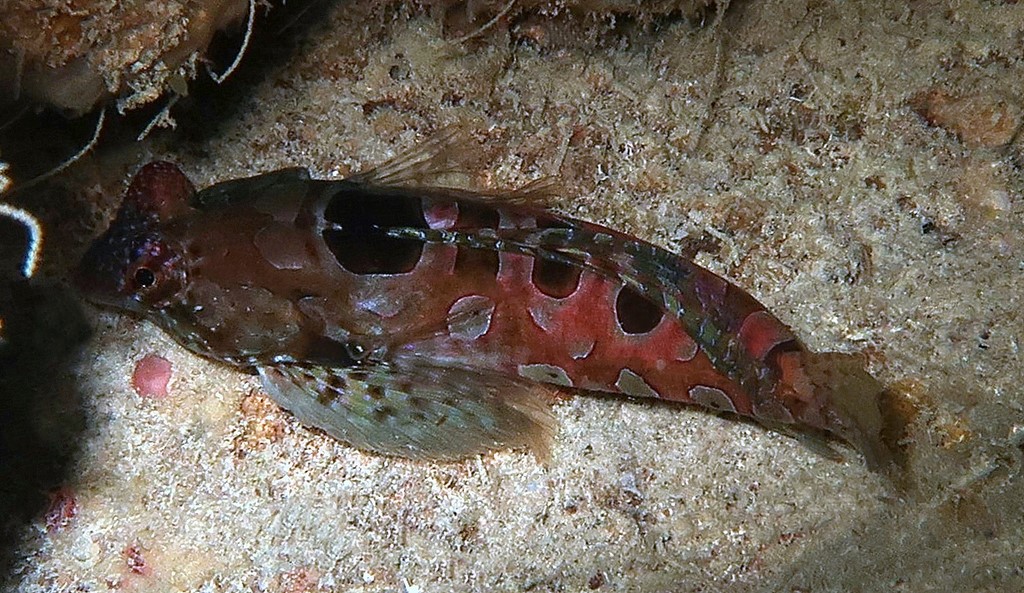SYNCHIROPUS CIRCULARIS - (FRICKE, 1984)
Picture courtesy of: Alain Daoulas
Actinopterygii (Gigaclass) > Actinopteri (Class) > Teleostei (Subclass) > Syngnathiformes (Order) > Callionymoidei (Suborder) > Callionymidae (Family) > Synchiropus (Genus)
Actinopterygii (Gigaclass) > Actinopteri (Class) > Teleostei (Subclass) > Syngnathiformes (Order) > Callionymoidei (Suborder) > Callionymidae (Family) > Synchiropus (Genus)
Mandarin cerclé, Dragonnet à cercles, Circled dragonet,
Description
Dorsal spines (total): 4; Dorsal soft rays (total): 8; Anal soft rays: 7-8 (usually: 7); Pectoral fin rays: 21-23; Pelvic fin rays: I, 5; Vertebrae: 6-7 + 14 (Totally: 20-21); Preopercular spine with a very long main tip and a formula 0[1/0]1. Body elongate and slightly depressed. Max. length: 2.3 cm SL. Depth range: 2 - 35 m.
Color
Circular white blotches on the side of the body and circular dark brown blotches on the back. The first dorsal fin in the male with oblique ocellate dark brown streaks, but without ocelli, and in the female basally dark brown, but distally whitish (except for a dusky distal margin).
Etymology
Synchiropus: from Greek prefix, syn-, symphysis = grown together + from Greek, cheiros = hand + from Greek, opous = foot. Referring to membrane connecting pelvic fin to pectoral fin (also present in Callionymus).
circularis: from Latin, circulus = circle (geometric figure). Named for circular white blotches on sides of body.
Original description: Synchiropus circularis Fricke, 1984 - Type locality: beach Cove cave, northwest of Tinian Town, Tinian, Marianas Islands, 14°59.7'N, 145°36.2'E, R.S. Jones, T. Tsuda, R. Struck & R. Randall, 15 August 1970.
Distribution
Western Pacific: Malaysia, Indonesia, New Guinea, Philippines, Mariana Islands, Chesterfield Islands and New Caledonia.
Dorsal spines (total): 4; Dorsal soft rays (total): 8; Anal soft rays: 7-8 (usually: 7); Pectoral fin rays: 21-23; Pelvic fin rays: I, 5; Vertebrae: 6-7 + 14 (Totally: 20-21); Preopercular spine with a very long main tip and a formula 0[1/0]1. Body elongate and slightly depressed. Max. length: 2.3 cm SL. Depth range: 2 - 35 m.
Color
Circular white blotches on the side of the body and circular dark brown blotches on the back. The first dorsal fin in the male with oblique ocellate dark brown streaks, but without ocelli, and in the female basally dark brown, but distally whitish (except for a dusky distal margin).
Etymology
Synchiropus: from Greek prefix, syn-, symphysis = grown together + from Greek, cheiros = hand + from Greek, opous = foot. Referring to membrane connecting pelvic fin to pectoral fin (also present in Callionymus).
circularis: from Latin, circulus = circle (geometric figure). Named for circular white blotches on sides of body.
Original description: Synchiropus circularis Fricke, 1984 - Type locality: beach Cove cave, northwest of Tinian Town, Tinian, Marianas Islands, 14°59.7'N, 145°36.2'E, R.S. Jones, T. Tsuda, R. Struck & R. Randall, 15 August 1970.
Distribution
Western Pacific: Malaysia, Indonesia, New Guinea, Philippines, Mariana Islands, Chesterfield Islands and New Caledonia.
Biology
Inhabits sand-rubble bottoms near reefs.
Last update: 17, May 2023
Inhabits sand-rubble bottoms near reefs.
Last update: 17, May 2023
